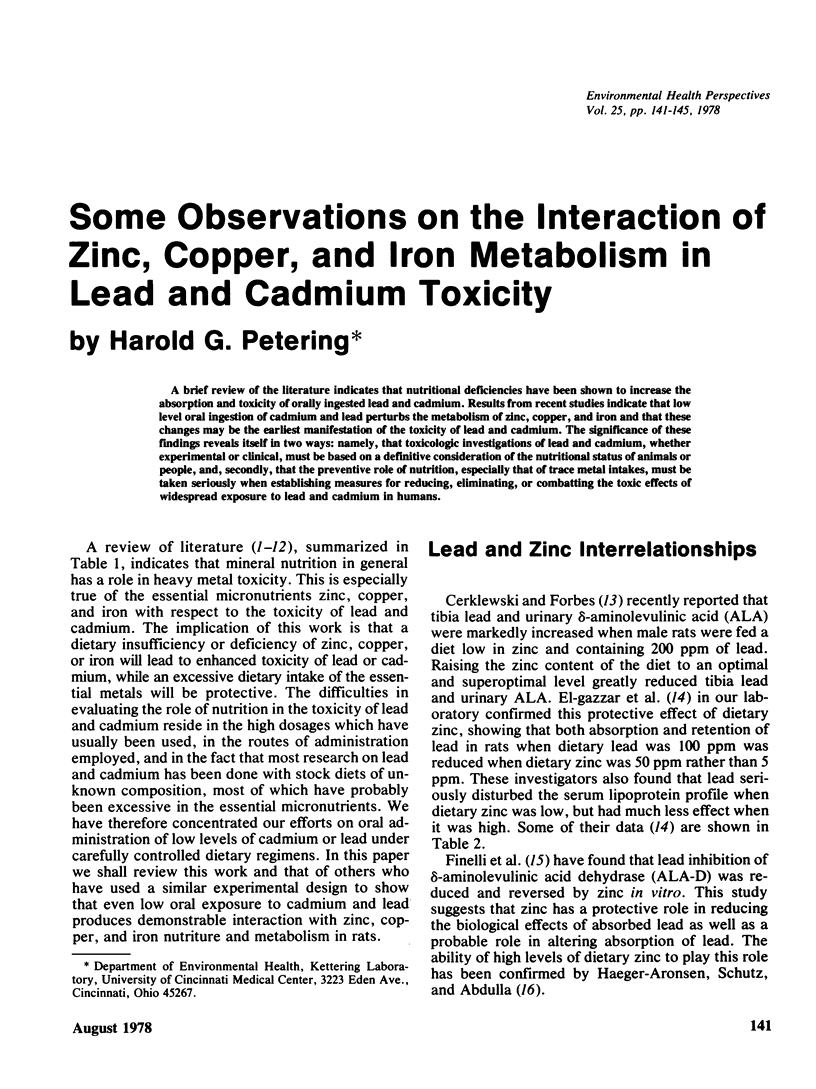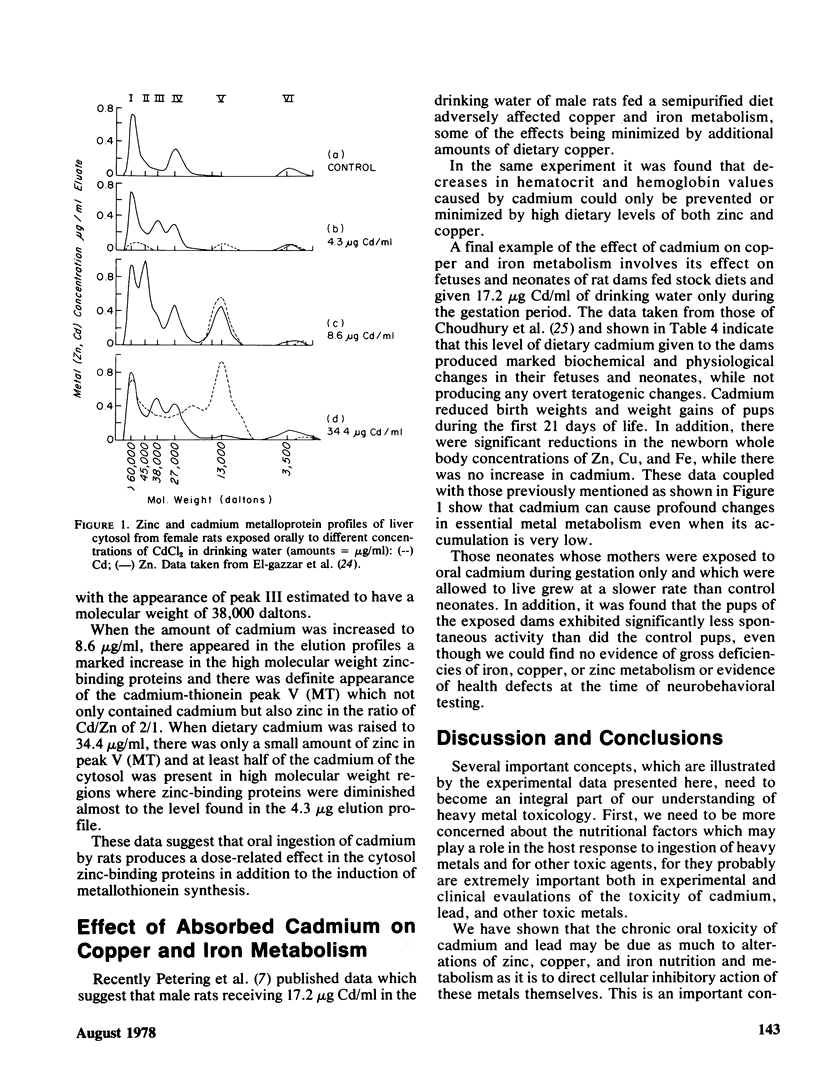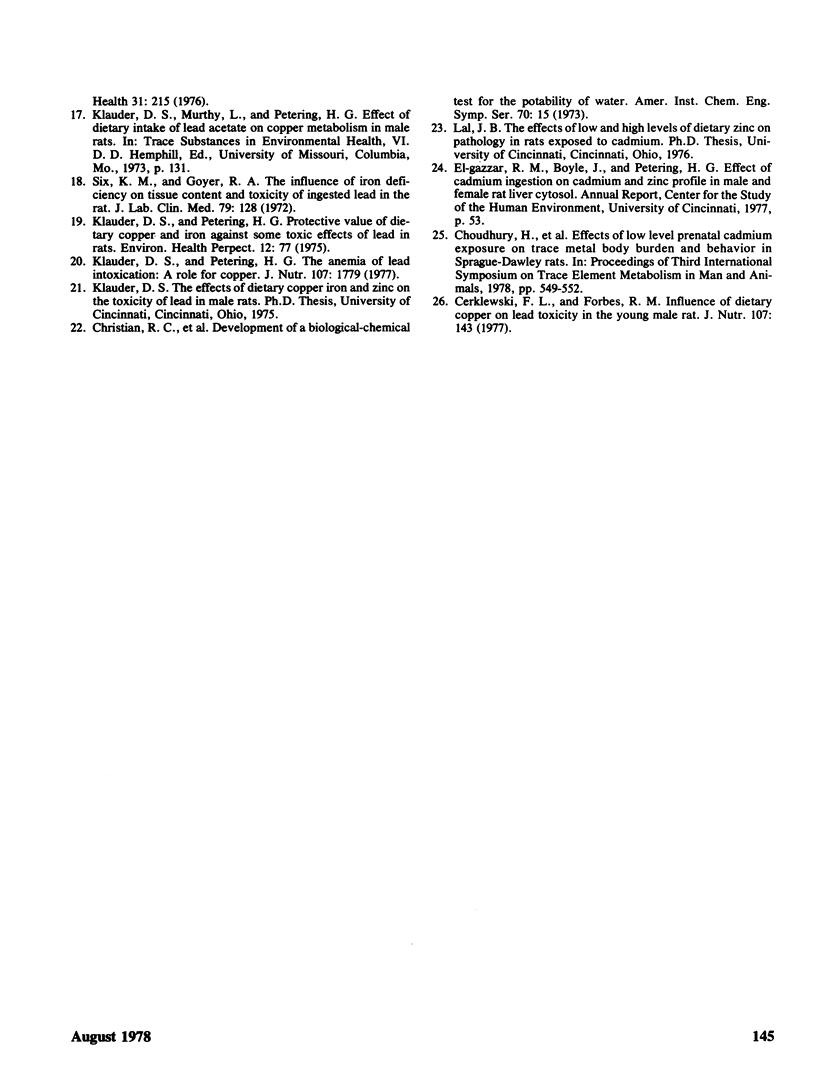Abstract
A brief review of the literature indicates that nutritional deficiencies have been shown to increase the absorption and toxicity of orally ingested lead and cadmium. Results from recent studies indicates that low level oral ingestion of cadmium and lead perturbs the metabolism of zinc, copper, and iron and that these changes may be the earliest manifestation of the toxicity of lead and cadmium. The significance of these findings reveals itself in two ways: namely, that toxicologic investigations of lead and cadmium, whether experimental or clinical, must be based on a definitive consideration of the nutritional status of animals or people, and, secondly, that the preventive role of nutrition, especially that of trace metal intakes, must be taken seriously when establishing measures for reducing, eliminating, or combatting the toxic effects of widespread exposure to lead and cadmium in humans.
Full text
PDF




Selected References
These references are in PubMed. This may not be the complete list of references from this article.
- Bunn C. R., Matrone G. In vivo interactions of cadmium, copper, zinc and iron in the mouse and rat. J Nutr. 1966 Dec;90(4):395–399. doi: 10.1093/jn/90.4.395. [DOI] [PubMed] [Google Scholar]
- Cerklewski F. L., Forbes R. M. Influence of dietary copper on lead toxicity in the young male rat. J Nutr. 1977 Jan;107(1):143–146. doi: 10.1093/jn/107.1.143. [DOI] [PubMed] [Google Scholar]
- Cerklewski F. L., Forbes R. M. Influence of dietary zinc on lead toxicity in the rat. J Nutr. 1976 May;106(5):689–696. doi: 10.1093/jn/106.5.689. [DOI] [PubMed] [Google Scholar]
- Doyle J. J., Pfander W. H. Interactions of cadmium with copper, iron, zinc, and manganese in ovine tissues. J Nutr. 1975 May;105(5):599–606. doi: 10.1093/jn/105.5.599. [DOI] [PubMed] [Google Scholar]
- Finelli V. N., Klauder D. S., Karaffa M. A., Petering H. G. Interaction of zinc and lead on delta-aminolevulinate dehydratase. Biochem Biophys Res Commun. 1975 Jul 8;65(1):303–312. doi: 10.1016/s0006-291x(75)80093-3. [DOI] [PubMed] [Google Scholar]
- Hamilton D. L., Valberg L. S. Relationship between cadmium and iron absorption. Am J Physiol. 1974 Nov;227(5):1033–1037. doi: 10.1152/ajplegacy.1974.227.5.1033. [DOI] [PubMed] [Google Scholar]
- Klauder D. S., Petering H. G. Anemia of lead intoxication: a role for copper. J Nutr. 1977 Oct;107(10):1779–1785. doi: 10.1093/jn/107.10.1779. [DOI] [PubMed] [Google Scholar]
- Klauder D. S., Petering H. G. Protective value of dietary copper and iron against some toxic effects of lead in rats. Environ Health Perspect. 1975 Dec;12:77–80. doi: 10.1289/ehp.751277. [DOI] [PMC free article] [PubMed] [Google Scholar]
- Larsson S. E., Piscator M. Effect of cadmium on skeletal tissue in normal and calcium-deficient rats. Isr J Med Sci. 1971 Mar;7(3):495–498. [PubMed] [Google Scholar]
- Petering H. G., Johnson M. A., Stemmer K. L. Studies of zinc metabolism in the rat. I. Dose-response effects of cadmium. Arch Environ Health. 1971 Aug;23(2):93–101. doi: 10.1080/00039896.1971.10665962. [DOI] [PubMed] [Google Scholar]
- Pond W. G., Walker E. F., Jr Effect of dietary Ca and Cd level of pregnant rats on reproduction and on dam and progeny tissue mineral concentrations. Proc Soc Exp Biol Med. 1975 Mar;148(3):665–668. doi: 10.3181/00379727-148-38606. [DOI] [PubMed] [Google Scholar]
- Six K. M., Goyer R. A. The influence of iron deficiency on tissue content and toxicity of ingested lead in the rat. J Lab Clin Med. 1972 Jan;79(1):128–136. [PubMed] [Google Scholar]


